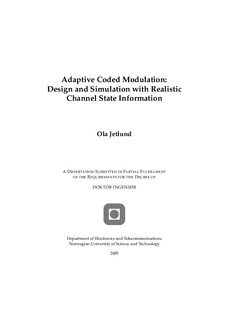| dc.contributor.author | Jetlund, Ola | nb_NO |
| dc.date.accessioned | 2014-12-19T13:42:40Z | |
| dc.date.accessioned | 2015-12-22T11:39:53Z | |
| dc.date.available | 2014-12-19T13:42:40Z | |
| dc.date.available | 2015-12-22T11:39:53Z | |
| dc.date.created | 2005-04-08 | nb_NO |
| dc.date.issued | 2005 | nb_NO |
| dc.identifier | 126090 | nb_NO |
| dc.identifier.uri | http://hdl.handle.net/11250/2368834 | |
| dc.description.abstract | Spectrally efficient transmission schemes are becoming a more common requirement for digital communication systems. Especially in wireless communication since the bandwidth of available frequencies is a shared resource. In addition, wireless communication systems suffer from transmission media with varying conditions. Adaptive coded modulation (ACM) has been suggested as a bandwidth-efficient transmission technique in wireless fading environments. The use of ACM is motivated by its ability to improve spectral efficiency (SE) by adapting the transmission rates to the variations in channel signal-to-noise ratio. Any ACM scheme rely on being able to predict future states of the transmission medium. Under idealized conditions, such as the prediction being perfect, an ACM scheme can be configured to maximize the SE under the condition of the bit error rate (BER) being below a specified target BER. Here, computer simulations of an example system show that such systems in some cases fail to achieve the target BER, since the idealized conditions used in the design process do not hold in a realistic setup.
By limiting the number of transmission modes, introducing imperfect prediction, and other practical conditions such as delay in the communication system and probability of outage, a more practical ACM scheme can be considered. We show that it is still possible to optimize the performance of such schemes. A wireless communication channel with a Rayleigh fading envelope is assumed here since most results then can be presented in closed form expressions. For other distributions of the fading, results can be found numerically. By optimizing the performance of an idealized ACM scheme using capacity achieving channel codes, we have been able to upper bound the SE of practical ACM schemes. The results also provide us with a technique to control the average BER in the case of imperfect knowledge of future channel states. Simulation results for a modified ACM scheme that uses this technique is shown to have an average BER that is less than the target BER | nb_NO |
| dc.language | eng | nb_NO |
| dc.publisher | Institutt for elektronikk og telekommunikasjon | nb_NO |
| dc.relation.ispartofseries | Doktoravhandlinger ved NTNU, 1503-8181; 2005:38 | nb_NO |
| dc.subject | Trådløs kommunikasjon | no_NO |
| dc.title | Adaptive coded modulation : design and simulation with realistic channel state information | nb_NO |
| dc.type | Doctoral thesis | nb_NO |
| dc.source.pagenumber | XXVII, 126 s. ill. | nb_NO |
| dc.contributor.department | Norges teknisk-naturvitenskapelige universitet, Fakultet for informasjonsteknologi, matematikk og elektroteknikk, Institutt for elektronikk og telekommunikasjon | nb_NO |
| dc.description.degree | dr.ing. | nb_NO |
| dc.description.degree | dr.ing. | |
